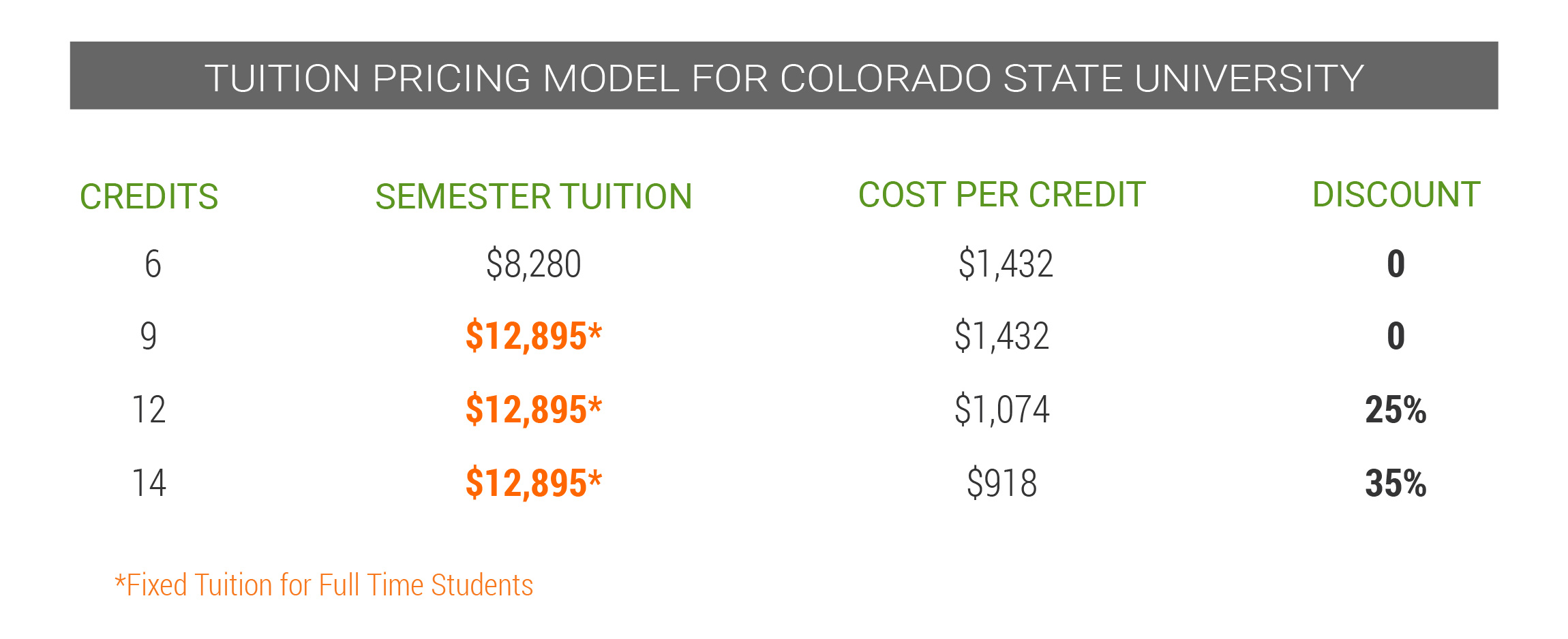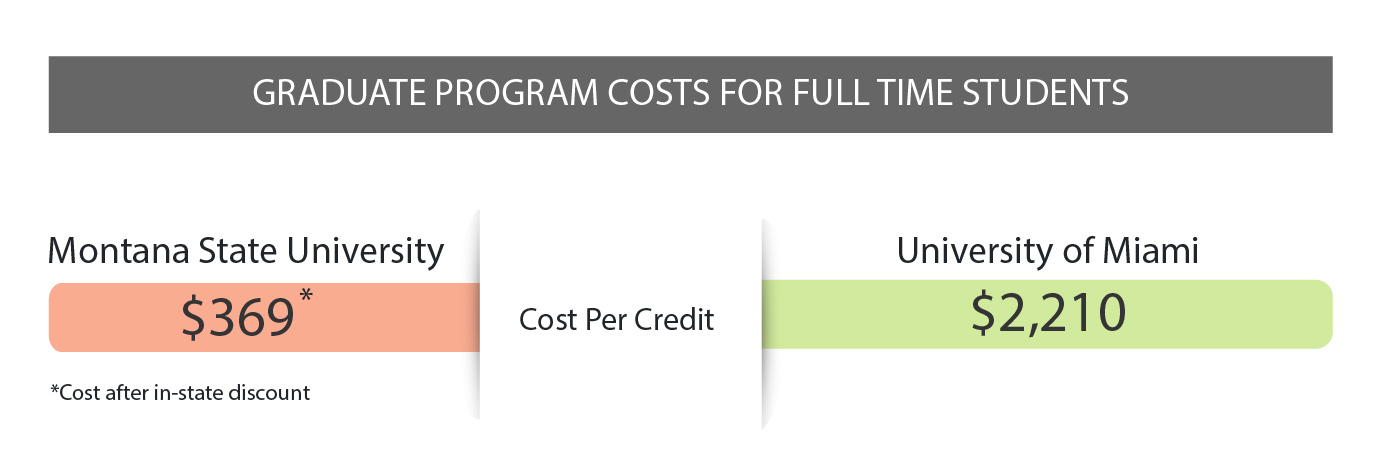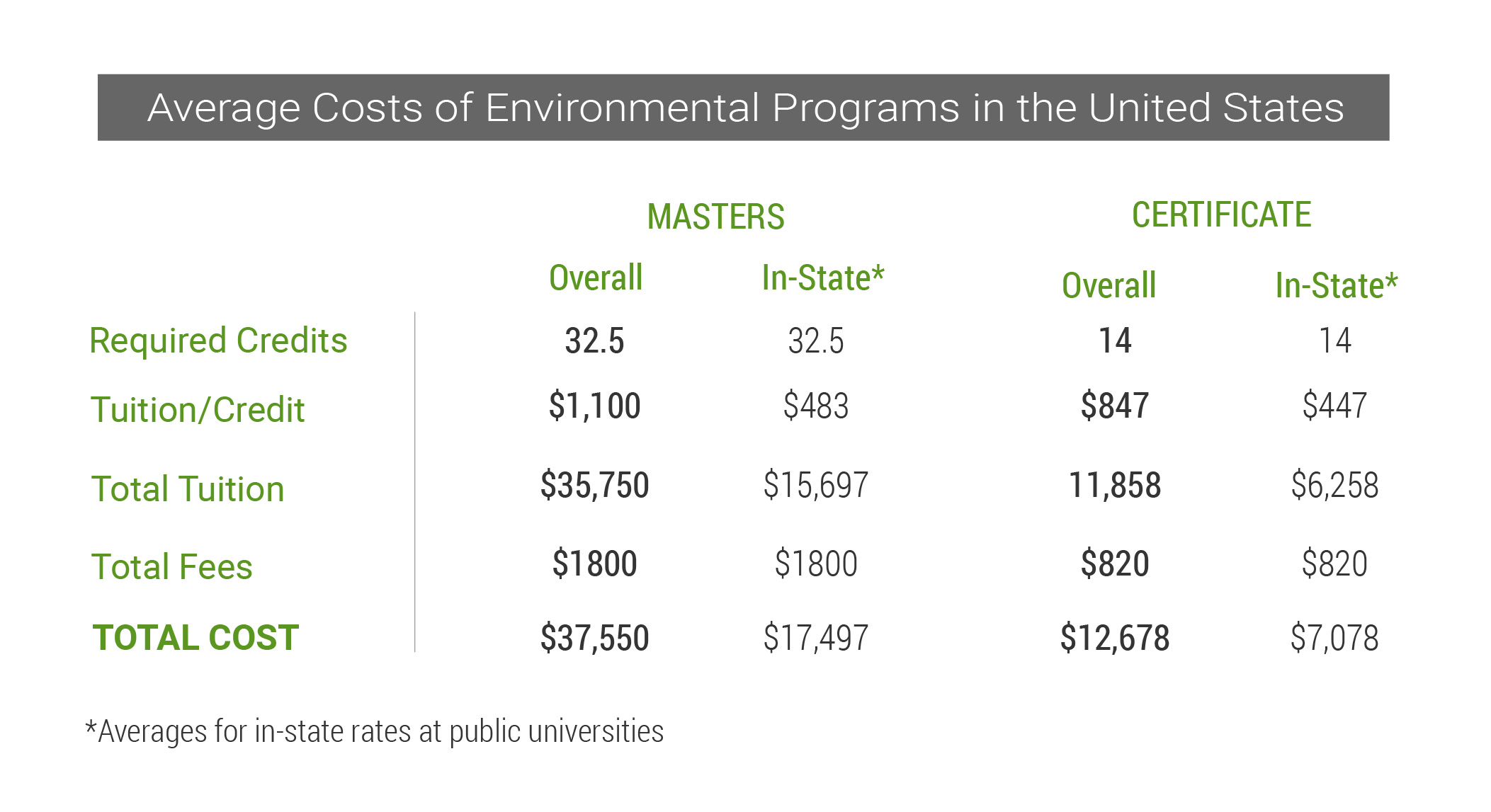College can be prohibitively expensive and graduate school is no exception. In 2020, the average environmental Master’s program cost $37,550 in the United States. When you consider the earning potential for environmental professionals (generally low) the cost of school may give you second thoughts about whether a graduate education is attainable.
But don’t feel too disheartened. Thankfully, there are a number of options available to students to help pay tuition and other associated expenses. In this article, we review the most common options in detail and we provide tips on how to secure that funding.
[cjbn_cta]
Assistantships
An assistantship is a form of academic employment that provides students with tuition reimbursement and certain financial benefits. Assistantship roles require specific work duties in support of a professor, a research lab, or a program department. You can think of them as part-time jobs, with a typical commitment of 20 hours per week.
In environmental fields, both Master’s and PhD programs frequently offer assistantships. In addition to tuition coverage, additional benefits can include:
- Modest stipend to cover living expenses
- Health insurance
- Student loan forgiveness
- Student housing
How Much Do Assistantships Pay?
Assistantship stipends range from $15,000 to $30,000 per academic year depending on the school. Your stipend may fall short in paying the bills. Student activists at campuses across the country have been pushing for a $15/hr minimum living wage. Some schools already pay above those levels. For example, Cornell University pays a $28,036 stipend for a 9-month academic year of work at 15 hours per week.
Types of Assistantships
Not all assistantships are the same. Environmental graduate programs generally offer 3 types of assistantships:
- Research Assistantships
- Teaching Assistantships
- General Graduate Assistantships
These 3 types differ in the main role that you perform, as reflected in their distinct nomenclature. They also differ in how you get them.
You might see the term “graduate assistant” thrown around. This is commonly used as a general name that can refer to any of the assistantship types.
Sound confusing?
No fear! We review each assistantship type in more detail below.
Research Assistantship

In a research assistantship, you work on a research project, usually under the supervision of a faculty advisor. Research assistants often work in a group or lab environment in close coordination with faculty, staff and other students. While rigorous, this work provides great hands-on research experience that culminates in the production of your thesis or dissertation and sometimes even publication in a scholarly journal.
How to Get a Research Assistantship
Available funding usually comes from grants secured by individual faculty members. For most research-based programs you need to engage with a prospective faculty adviser and ask them if they would be willing to take you on as a graduate student BEFORE you formally apply to the school.
Sometimes, faculty will explicitly advertise research assistantship opportunities. Below we list some sources where you can find these opportunities listed for environmental fields:
[background_block]
Find Assistantship Postings
Directly on a lab or faculty’s web page (look for an “Opportunities” link)
Texas A&M University Agriculture & Life Sciences Graduate Assistantships
Ecophys Jobs Graduate Opportunities
Conservation Job Board
American Fisheries Society
Northern Kentucky University Rick Boyce Graduate School Opportunities
CJB Network
[/background_block]
Many professors do not advertise available funding. Often, you will need to contact faculty directly to inquire about whether or not funding is available. In some cases, funding for a research assistantship can become available at some point after you enroll. But you should hesitate to enroll in a program based on the expectation that you will secure funding later. It may not happen.
If a professor does not have funding available, they may still be willing to take you on as a student but you will need to pay your own way (or cover your tuition through another method).
Teaching Assistantship
 Teaching Assistantships provide another source of potential funding for graduate students. The responsibilities of a teaching assistant can vary depending on the needs of the department or professor. Roles could include setting up lab equipment, grading tests and assignments, proctoring quizzes, keeping office hours, creating syllabi, and – of course – actually teaching classes. Before applying for a Teaching Assistantship, you should always try to find out what responsibilities the position will entail.
Teaching Assistantships provide another source of potential funding for graduate students. The responsibilities of a teaching assistant can vary depending on the needs of the department or professor. Roles could include setting up lab equipment, grading tests and assignments, proctoring quizzes, keeping office hours, creating syllabi, and – of course – actually teaching classes. Before applying for a Teaching Assistantship, you should always try to find out what responsibilities the position will entail.
How to Get a Teaching Assistantship
The application process for Teaching Assistantships varies by school. In some cases, you can apply for these positions beforehand as part of your overall application to the university. For some schools, you apply after enrolling. For example, the Department of Ecology at Montana State University chooses Teaching Assistants mid-semester, to become active in the following term.
Schools award these assistantships based on a variety of criteria including student merit, financial need, seniority and the specific teaching needs of the department. Before applying for a Teaching Assistantship, you should confirm what criteria the school uses in its decision making. Successful applicants often carry a high GPA, good GRE scores and relevant teaching experience.
General Graduate Assistantship
Some schools offer assistantships that provide general support to the needs of the department. You might help with any of the following:
- Office and lab maintenance
- Clerical and receptionist duties
- Tech support
- Recruiting
Similar to Teaching Assistantships, the application process and hiring criteria for these positions vary from school to school.
Fellowships, Grants, and Scholarships
For graduate school, you will see the word “Fellowship” or “Grant” used more than “Scholarship.” The three terms usually refer to a similar concept – a source of free money awarded to students by the schools themselves or outside funders to cover education-related expenses.
Common Types of Fellowships and Grants
Fellowships and grants for graduate school can vary widely in the size of the awards, what expenses they cover, and the focus of the funding. Below, we outline some common types of fellowships and grants that you will encounter:
Fellowships as Scholarships – Many graduate fellowships and grants mirror the concept of the “scholarships” that you would find for undergraduate students. These awards cover all or most of your tuition. However, graduate fellowships tend to use merit-based criteria.
Research Fellowships – Research fellowships provide funding to students to support their graduate research. Some awards fully cover tuition and provide a stipend so you can pursue your own research idea. As such, research fellowships can provide a funding alternative to assistantships. We discuss this in more detail in the section, “Funding Your Own Research” below.
Career Development Fellowship – Some fellowships support professional development in a field by providing funding for you to go to school and build your skills. Unlike research-based funding, these awards can pay for your education in non-thesis and online professional programs. Some of these fellowships require recipients to work in the field for a certain amount of time after earning their degree.
Example: The American Association of University Women (AAUW) Career Development Grants provide $2,000 – $12,000 to change careers in education, health, or social sciences.
Small Awards – Many funding sources provide small one-time awards or grants that follow some specific mission or purpose. These awards typically range from $250 to $2,000 and can help ease the financial burden of graduate school.
Specific Expense Grants – Similar to Small Awards, many funding sources will cover a specific expense item related to your graduate education. A common example, travel grants and conference grants can pay for you to attend events or participate in field experiences.
Need-Based Funding – A number of government and foundation programs provide need-based funding for graduate school.
Where to find Fellowships and Grants

Internal Sources of Funding
Schools and their departments can provide fellowship and scholarship funding for students. You can research this on the university and department websites. For example, UC Davis offers multiple internal sources of funding to students in the Graduate Group in Ecology.
If you are considering a graduate program, you should inquire about the availability of these internal sources of money, especially if you are not able to secure an assistantship.
External Sources of Funding:
You can apply for fellowship and scholarship funding from a variety of external sources including foundations, non-profits, government, and even for-profit companies. Below we list some websites where you can find fellowship and grant funding sources for environmental fields:
[background_block]
Where to Search for Funding:
University of Kansas – Grad School Funding Listing
Pathways To Science – Education and career training opportunities in STEM
Montana State University – Funding Sources for Graduate Students
[/background_block]
Tips for Securing Funding
- Start Early – Identify what you might be eligible for before you are eligible.
- Research – Ask for direction from departments and universities, grant fellowship offices, foundations in your field (or outside), or specialized organizations.
- Follow Application Instructions -Follow instructions or you risk having your application immediately tossed for overlooking the details
- Connect – Connect with students who have received funding. Reach out and ask them about their experience. They can often provide insight that will help you with your applications.
- Share – Use your cover letter to showcase your qualifications. Give examples to back up your claims and be specific.
- Expand – Ask someone outside your field of study to review your application to make sure you have explained yourself and your proposal well.
- Be Persistent- There is no such thing as failure, just growth! Applying for money is hard and rejection is common. Develop a thick skin, use feedback as a tool and get back out there.
[newsletter-signup]
Funding your Own Research
You do not need to rely on funding provided by a professor to pay for your graduate research and education.
As we discussed earlier, fellowships can provide funding for you to pursue a research topic. If you are unable to secure an assistantship, then a research fellowship or grant can provide an alternative source of money to help pay for your education.
Some highly competitive and prestigious fellowships will fully cover your graduate education and provide a stipend. These fellowships boast some advantages over research assistantships.
Advantages of Research Fellowships
Research fellowships can boast some advantages compared to other funding sources
- Unlike assistantships, research fellowships typically lack work requirements.
- Fellowships can provide more academic freedom to pursue your own research interests. With an assistantship, your research will typically follow a predefined scope which may not be your ideal topic.
- With some fellowships, you can secure funding before you apply to schools. More schools and faculty advisers will want to bring you on if you have your own money. You can be more selective in your decision making.
- Fellowships showcase your tenacity as an independent researcher from the get-go. They can build your prestige and create additional tangible benefits. For example, Brown University offers an incentive program for students who are awarded outside funding.
[horizontal_quote]
“Fellowships are good because they give you much more freedom to choose your own research topics”.
-Phil Agre, a former UCLA faculty member with UCLA, discussed in considerations for grad school.
[/horizontal_quote]
Where to Look for Funding
Do your own research and explore organizations, foundations and society groups in your field of interest.
Many students start their search with the National Science Foundation (NSF). As an independent federal agency, the NSF works to promote progress in science. Applicants submit over 50,000 research proposals annually to the agency. The NSF funds about 11,000.
NSF offers a program specifically for graduate students, the NSF Graduate Research Fellowship Program (GRFP). The program focuses on funding students early in STEM research fields.
PRO TIP: Many research grants exclusively fund organizations rather than individuals. But don’t rule these out completely. The Southern Illinois Grant Funding: A Guide for Graduate Students suggests teaming up with your adviser to apply for these grants through your university to help fund your research.
Work-Study
Work-study refers to a federal program that provides funding for part-time jobs for students with financial need. According to the U.S. Department of Education, 3,400 colleges and universities have a Federal Work-Study Program. These programs allow students to earn money to help pay for educational expenses. The first step to acquiring a work-study position is filling out that same Free Application for Federal Student Aid you fill out for loans (discussed in the next section).
Keep in mind that qualifying for work-study doesn’t guarantee you a job. You will have to secure a position with your school or a qualifying federal, state, or local public agency; a private nonprofit organization; or a private for-profit organization.
Pro Tip: There may be certain restrictions associated with work-study. For example, graduate students at the University of Denver cannot utilize a work-study job and have an assistantship in the same quarter.
Student Loans
Depending on your financial situation you may need to take out student loans to pay for school. Loans provide borrowed money for you to pay for school and other associated costs. With most loans, you will ultimately pay back the amount you borrow plus interest.
If you are considering a student loan, you should first fill out your Free Application for Federal Student Aid (FAFSA®). These forms need to be submitted between January and March of the year prior to the start of school.
Private lenders are also an option. These are usually banks or financial institutions.
Whichever options you consider, pay close attention to the interest rates. They can dramatically increase the debt you accrue.
Admissions advisor at New Mexico State University, Austin Gentry says, “We would much rather have our students turn to grants, work-study — any other source of aid — before they turn to loans.” –via Nerd Wallet
Pro Tip: Do your homework when it comes to loans. Build out a comprehensive repayment plan, the earlier you can pay them off the less you will inevitably pay over time.
Self Finance
Consider self-financing with great care. Many resources are available to help fund graduate school and lessen financial burdens. Make sure you are financially prepared for the costs if you choose to take them on and have a solid plan to meet all your financial obligations.
Before You Go to School

When comparing schools and programs keep an ongoing list of questions to ask administrators and faculty. You want to have all the information you need to make the best decision for your future.
We have compiled our top 10 questions below.
- What percent of graduate students receive funding?
- How are they typically funded?
- What are the stipend levels?
- Are additional benefits provided like health insurance or housing?
- Do assistantships waive tuition costs?
- In addition to tuition, what additional fees am I responsible for?
- How long does the average student take to complete their degree?
- What are the service requirements associated with assistantships?
- What is the time commitment for assistantships? How often do students exceed that time weekly?
- What is the average cost of living in the area?
[newsletter-signup]
[background_block]
 Alyson Morris is the communications specialist for CJB Network and writes on environmental career development. She is also a graduate student at the University of Oregon and is pursuing her Master’s in Strategic Communication.
Alyson Morris is the communications specialist for CJB Network and writes on environmental career development. She is also a graduate student at the University of Oregon and is pursuing her Master’s in Strategic Communication.
[/background_block]






